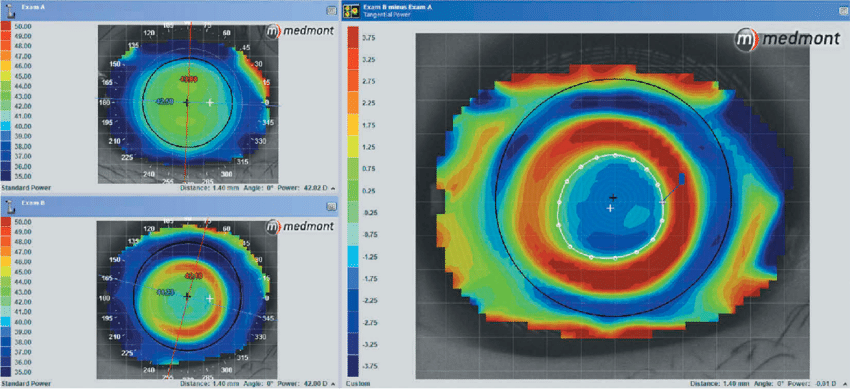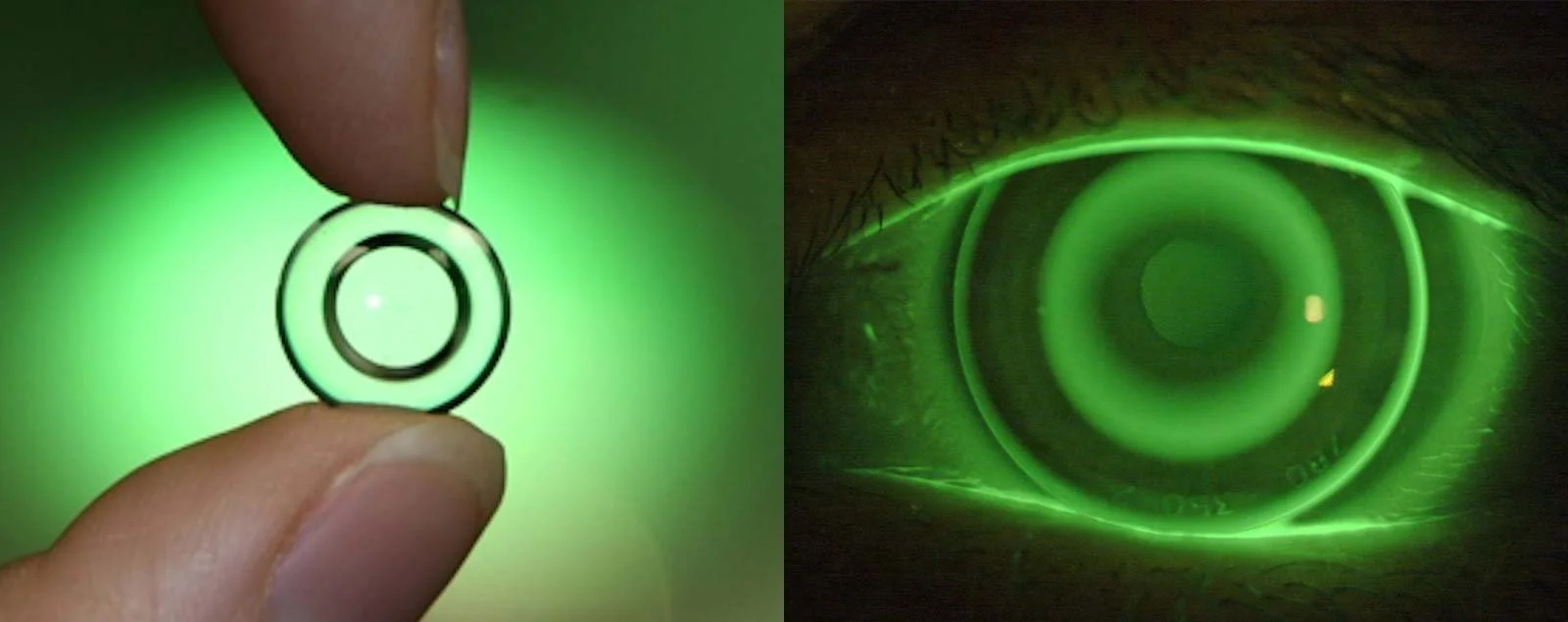Orthok: night time contact lenses for children and adults
Orthokeratology (Orthok) is a non-surgical treatment using specialized overnight contact lenses to temporarily reshape the cornea.
Orthok in children:
It offers two key benefits: correcting myopic vision and slowing myopia progression, known as myopia control.
Orthok has been shown to slow myopia progression by about 50%, which reduces the risk of future eye conditions like glaucoma and retinal detachment associated with high myopia.
The lenses are worn overnight, providing clear vision during the day. While Orthok is suitable for children as young as 6 years old, its effectiveness tends to be greater when started early, and it is usually continued until myopia stabilizes in late adolescence or early adulthood.
Orthok in adults:
Orthokeratology (Orthok) can also be used in adults, though its primary application is in children for myopia control. In adults, Orthok is often employed for vision correction, offering an alternative to daytime contact lenses or glasses. Adults benefit from Orthok by experiencing clear daytime vision without the need for corrective lenses, making it particularly appealing for those with active lifestyles or those who work in environments where glasses or soft contacts may be impractical.
Alternative to refractive surgery
Orthok offers a non-surgical and reversible alternative to refractive surgery, such as LASIK (laser eye surgery) - this is a good option for adults those who prefer not to undergo surgery, or who are not suitable for surgery.
How does Orthok work?
Orthok lenses are worn overnight to temporarily reshape the cornea. By gently flattening the central cornea, the lenses change how light enters the eye, refocusing it onto the retina, thus correcting vision. The reshaping effect typically lasts throughout the day, allowing for clear vision without the need for daytime glasses or contact lenses.
In addition to vision correction, Orthok also focuses peripheral light rays in front of the retina, which has been shown to slow the progression of myopia. This dual mechanism—correcting central vision and controlling peripheral light focus—is why Orthok is popular for myopia control.
Process of Orthok fitting:
The fitting process for orthokeratology (Orthok) is meticulous and involves several steps to ensure safety and effectiveness.
Initial Consultation: The optometrist assesses the patient's suitability by conducting a detailed eye examination. This includes measurements of corneal topography to map the surface of the cornea, along with assessing refractive error (e.g., myopia or astigmatism) and overall eye health.
Custom Lens Fitting: Based on the topography data, custom Orthok lenses are designed to fit the patient’s eyes. These lenses are worn overnight and gently reshape the cornea to correct vision. Over the course of several days or weeks, the optometrist will adjust the lenses if needed.
Follow-up Visits: After the initial fitting, follow-up visits are essential to monitor the eye’s response to the lenses. These visits allow the optometrist to ensure that the lenses are reshaping the cornea effectively and safely.
Combination Therapy: Some practitioners combine Orthok with low-dose atropine to enhance the myopia control effect. This combination has shown promising results, especially for children with rapidly progressing myopia.
Chen, Ruru & Chen, Yan & Lipson, Michael & Kang, Pauline & Lian, Hengli & Zhao, Yune & McAlinden, Colm. (2019). The Effect of Treatment Zone Decentration on Myopic Progression during Orthokeratology. Current Eye Research.
Safety of Orthok:
Orthok is considered a safe procedure, especially when fitted by experienced practitioners. According to the Orthokeratology Society of Oceania (OSO), the procedure has been proven safe over many years, with complications being rare when proper hygiene and fitting protocols are followed. However, as with any contact lens wear, there is a small risk of infections such as microbial keratitis, which underscores the importance of good lens care and regular follow-ups.
Studies also show that long-term use of Orthok for myopia control is effective without significant adverse effects when managed correctly. However, children who wear Orthok need to be monitored closely for any signs of discomfort or vision changes.
Comparison with Other Myopia Control Treatments:
Orthok vs. Soft Multifocal Lenses: Both Orthok and soft multifocal contact lenses are effective in controlling myopia, but Orthok has the added benefit of providing clear vision without the need for daytime lenses.
Orthok vs. Atropine Drops: Atropine eye drops can slow myopia progression more than Orthok alone, but they do not correct vision. Therefore, glasses or contact lenses are still needed when using atropine.
Combination Therapy: Some practitioners combine Orthok with low-dose atropine to enhance the myopia control effect. This combination has shown promising results, especially for children with rapidly progressing myopia.
How many years do myopic children need orthok for?
Orthok is typically worn throughout childhood and adolescence, until myopia progression slows or stabilizes, which generally happens in the late teens to early adulthood. Discontinuing Orthok prematurely may result in a rebound effect, where myopia rapidly worsens again. Continuous wear is required to maintain the reshaping effect.
Types of Prescriptions That Orthok Can Correct:
Orthok is effective for correcting a variety of refractive errors, though its suitability depends on the severity and individual corneal characteristics. Below are the main types of prescriptions that Orthok can address:
Myopia (Shortsightedness): Orthok is primarily used to treat myopia, correcting up to around -6.00 diopters (D) in most cases. Candidates with mild to moderate myopia tend to achieve the best results. Higher levels of myopia may require more customized lens designs, and success rates can vary depending on the patient’s corneal shape.
Astigmatism: Orthok can correct mild to moderate astigmatism, typically up to -1.50D with standard spherical lenses. For higher degrees of astigmatism (up to -3.50D), toric Orthok lenses may be used. The lens design must account for the corneal toricity to prevent lens decentration and ensure optimal correction.
Hyperopia (Farsightedness): Although less common, Orthok can correct hyperopia up to about +2.00D. Hyperopic Orthok treatment reshapes the cornea to increase its curvature, allowing light to focus properly on the retina. The effectiveness of this treatment depends on the individual’s corneal structure.
Presbyopia (Age-related Farsightedness): Orthok can also be adapted for presbyopia using multifocal Orthok lenses. These lenses are designed to provide both distance and near vision correction by creating different zones of focus on the cornea. While presbyopic patients may benefit from these lenses, the results can be more variable compared to other refractive errors, as presbyopia involves age-related changes in the eye's lens rather than the cornea.
How can we determine whether orthok is working effectively
To determine if myopia control treatments like Orthok, soft multifocal lenses, or atropine drops are working, several key indicators can be monitored:
Stabilization of Prescription: The most reliable way to tell if myopia control is effective is by tracking changes in the patient's prescription over time. A slowing or stabilization of myopic progression, indicated by smaller increases in diopters (less change in shortsightedness), suggests the treatment is working. Optometrists typically measure refractive changes during regular follow-up visits.
Axial Length Measurement: Another critical factor is the axial length of the eye, which increases as myopia worsens. Slower growth of the axial length, measured by devices such as an optical biometer, is a strong indicator that the treatment is effectively controlling myopia progression(
Vision Quality: Patients should maintain stable, clear vision with fewer fluctuations throughout the day. If the quality of vision is consistently good and does not deteriorate rapidly, it is a positive sign that myopia control is functioning as intended.
Annual Progression Comparisons: For children and teenagers, annual comparisons are useful. Myopia progression is typically fastest in younger children, so if the progression rate is reduced compared to age-expected rates or previous years, it is a sign of effective myopia control
(more details on Myopia progression in this blog post)
How to Use and Care for Orthok Lenses:
Insertion and Removal:
Insertion: Before inserting your Orthok lenses, ensure your hands are clean and dry. Gently place the lens on your fingertip and apply a few drops of lubricants prescribed by your optometrist. With your head facing down, use one hand to hold the upper eyelid and the other to insert the lens directly onto the center of the cornea. You should close your eyes and be in bed within about 5 minutes of inserting the lenses.
Removal: In the morning, after sleeping with the lenses, use a suction plunger (lens remover) to gently remove the lens. Ensure the eyes are well-lubricated before removal to avoid irritation.
Handling Tips:
Hygiene: Always wash and dry your hands before handling Orthok lenses.
Avoid Water: Never rinse Orthok lenses with tap water, as it can introduce harmful microorganisms, increasing the risk of infection.
Case Care: Replace the lens case every 1-3 months, and always keep it dry when not in use to prevent bacterial growth.
Regular Maintenance:
Periodic Deep Cleaning: Every few weeks, use an enzymatic cleaner to remove protein deposits that accumulate on the lenses over time.
Lens Replacement: Orthok lenses generally last about one to three years, depending on care and usage. They should be replaced sooner if they become scratched or damaged.
Monitoring Eye Health:
Regular Check-ups: Schedule regular follow-up visits with your optometrist to monitor your eye health and ensure that the lenses are functioning correctly. Report any signs of discomfort, redness, or vision changes to your optometrist promptly.
Backup glasses:
Even if you're using Orthok lenses, having a backup pair of glasses is important. These backup specs ensure that you have clear vision in case you cannot wear your Orthok lenses—such as when you are experiencing discomfort, when you have an eye infection, if you have misplaced or broken a lens, or if you choose to take a break from lens wear (during travel, etc.). The prescription for your backup glasses may be lower than your original prescription, as Orthok reduces myopia, so regular check-ups with your optometrist are important to keep your glasses up to date.
Summary:
Orthok is a non-surgical, overnight vision correction treatment that corrects refractive error and also helps slow the progression of myopia. The fitting process includes assessments, trial lenses, and follow-ups to ensure safety and effectiveness. While it offers freedom from daytime lenses, Orthok requires proper hygiene and long-term wear for sustained results. For even greater control over myopia progression, combination therapy with atropine eye drops may be beneficial.
Author Bio
Jenny Wu is an optometrist based in Canberra, Australia. She is a full scope optometrist specializing in dry eye, specialty contact lenses, myopia control, and orthok. She practices at Simpson Optometry. In her spare time she enjoys spending time in nature, photography, gardening, and being with her husband (also an optometrist) and 2 children.





